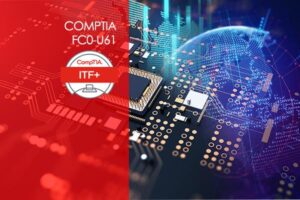Course Overview
CompTIA IT Fundamentals training often referred to as ITF+, helps anyone learn about IT. Students learn fundamental skills needed in the IT industry. Areas of IT covered include hardware, software, programming, security, and infrastructure. This is the ideal place to start for anyone new to the world of IT. It will form the foundation of your learning IT principles and skills. What you learn in this course will carry you forward to more certifications you can gain in the future.

Course objectives
The official exam offered by CompTIA for this certification is exam id FCO-U61. The exam assesses a candidate’s knowledge of troubleshooting theory and preventative maintenance. Students look at issues behind problems and resolve them using technical IT skills. Candidates show they can incorporate methods to eliminate technical issues. This is the ideal exam for anyone who’s interested in pursuing an IT career and has a genuine passion for IT.
Modules
Module 1 – IT Concepts and Terminology
- 0.1 Instructor Intro
- 1.1 Compare and Contrast Notational Systems
- 1.1 Compare and Contrast Notational Systems Demo
- 1.2 Compare and Contrast Fundamentals Data Types and Their Characteristics
- 1.3 Illustrate the Basics of Computing and Processing
- 1.4 Explain the Value of Data and Information
- 1.5 Compare and Contrast Common Units of Measures
- 1.5 Compare and Contrast Common Units of Measures Demo
- 1.6 Explain the Troubleshooting Methodology
Module 3 – Applications and Software
- 3.1 Explain the Purpose of Operating Systems
- 3.1 Explain the Purpose of Operating Systems Demo
- 3.2 Compare & Contrast Components of an Operating System
- 3.2 Compare & Contrast Components of an Operating System Demo
- 3.3 Explain the Purpose & Proper Use of Software
- 3.4 Explain Methods of Application Architecture & Delivery Models
- 3.5 Given a Scenario Configure & Use Web Browsers
- 3.5 Given a Scenario Configure & Use Web Browsers Firefox
- 3.5 Given a Scenario Configure & Use Web Browsers Demo Chrome
- 3.5 Given a Scenario Configure & Use Web Browsers Demo Edge
- 3.6 Compare & Contrast General Application Concepts & Uses
Module 5 – Database Fundamentals
- 5.1 Explain Database Concepts and the Purpose of Databases
- 5.2 Compare and Contrast Various Database Structures
- 5.3 Summarize Methods Used to Interface with Databases
- 5.3 Summarize Methods Used to Interface with Databases
Module 2 – Infrastructure
- 2.1 Classify Common Types of Input-Output Device Interfaces
- 2.2 Given a scenario, set up & install Common Peripheral Devices to a PC
- 2.2 Given a scenario, set up & install Common Peripheral Devices to a PC Demo
- 2.3 Explain the Purpose of Common Internal Computing Components
- 2.4 Compare & Contrast Common Internet Service Types-
- 2.5 Compare & Contrast Storage Types
- 2.6 Compare & Contrast Common Computing Devices & Their Purposes
- 2.7 Explain Basic Networking Concepts
- 2.7 Explain Basic Networking Concepts
- 2.7 Explain Basic Networking Concepts Part 2
- 2.7 Explain Basic Networking Concepts Part 3
- 2.7 Explain Basic Networking Concepts Part 4
- 2.8 Given a scenario Install, Configure & Secure a Basic Wireless Network
- 2.8 Given a scenario Install, Configure & Secure a Basic Wireless Network
Module 4 – Software Development
- 4.1 Compare & Contrast Programming Language Categories-
- 4.2 Given a Scenario Use Programming Organizational Techniques & Interpret Logic
- 4.3 Explain the Purpose & Use of Programming Concepts
- 4.3 HTML
Module 6 – Security
- 6.1 Summarize Confidentiality, Integrity, and Availability Concerns
- 6.2 Explain Methods to Secure Devices and Best Practices
- 6.3 Summarize Behavioral Security Concepts
- 6.4 Compare & Contrast Authentication, Authorization, Accounting, & Repudiation Concepts
- 6.5 Explain Password Best Practices
- 6.6 Explain Common Uses of Encryption
- 6.7 Explain Business Continuity Concepts
- 6.8 Takeaways
- 6.9 ITF Fundamentals Conclusion
Modes of Learning
You best learn when you see it. Our easy-to-understand video content is in place for you. Watch the studying content and grasp all the concepts easily. With so many lectures and 3000+ hours of video content, find what suits your needs. These educational videos are designed to sharpen your experience with your training content. Our easy-to-understand video content is in place for you. Watch the studying content and grasp all the concepts easily.
In contrast to other e-learning services, our labs will let you exercise what you analyze in a real environment with a lot to choose from. This layout mirrors the traditional study room format which ensures you will recognize exactly the way to set up, manage and troubleshoot any environment.
Being a successful IT professional involves more than knowing key terms and concepts. You need to be able to “apply” your knowledge to real-world situations. At EZDA we quote, “Learn it to pertain to it.” So, why spend money buying the equipment when we got you all covered?
- Flashcards: Remember the “read and guess” games we used to play back then? Here’s to enhance what you learned. How does it work? A statement will be written on a flashcard, and you’ll need to guess the answer. Then flip it over to see if you answered it correctly. The cards continue, each with a random statement from the course that you took previously.
- Scatter: “Make Everything Disappear.” Turn the screen white and vanish it all but this time testing your knowledge and your time being monitored. Find the best match and click your way toward success. This brain teaser might give you a hard time! But education combined with games adds an element of fun to it.
- Learn: Here’s another. Read and choose the right answer. A game designed on a Multiple-Choice pattern. This kind of exercise boosts your confidence. When one option seems to be correct, you choose the other only for it to be the right option. The right option will welcome another statement, but don’t sweat! You are still learning.
- Speller: This fun-packed game is unique in its own way. Hear the term carefully and type it out on your screen. You think you are a pro at learning spellings of tricky terms. Test yourself out with this game. Could you hear it properly? If you could, were you able to write it?
We have found our students doing absolutely great by showcasing their certificates. Grab that certificate of yours before someone else does and get that recognition you deserve.

